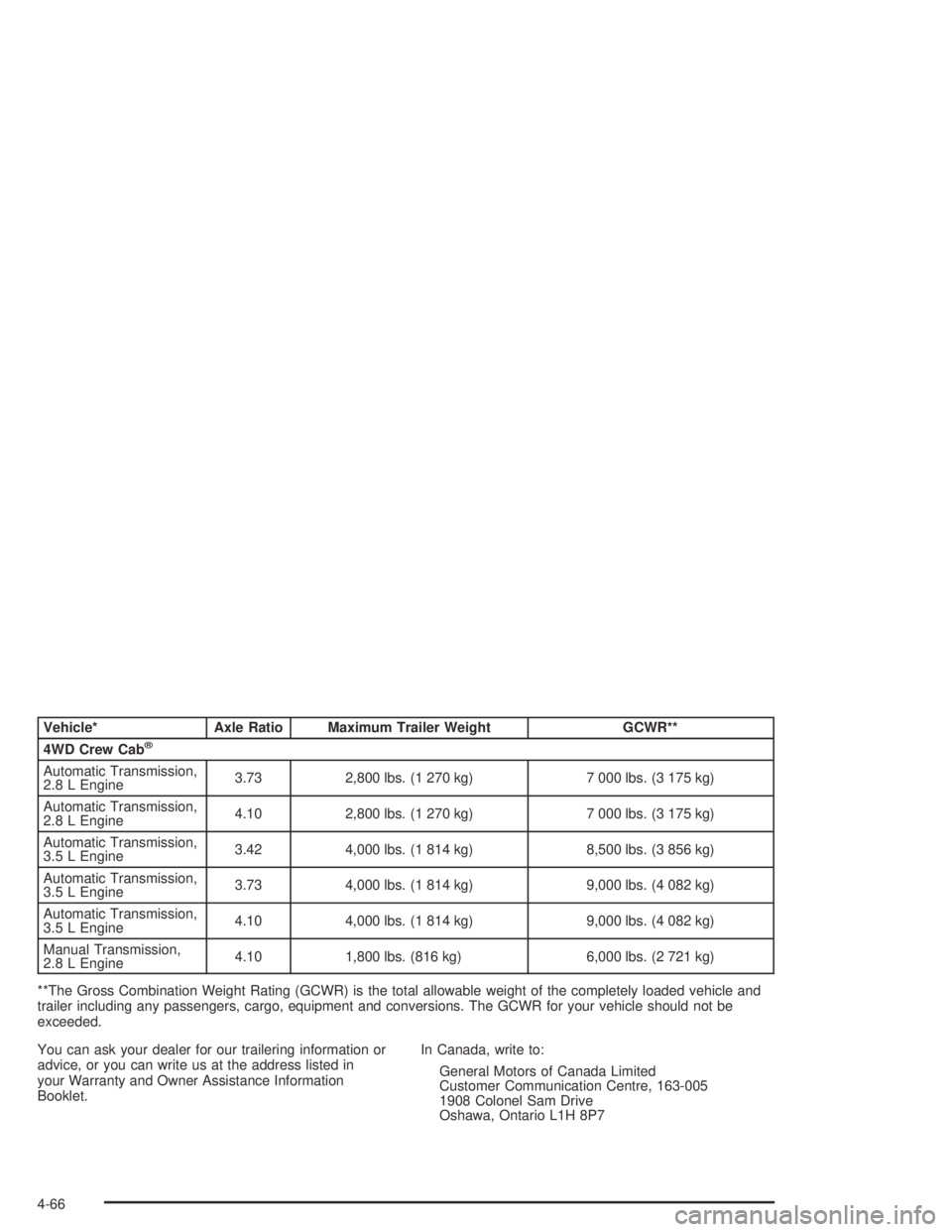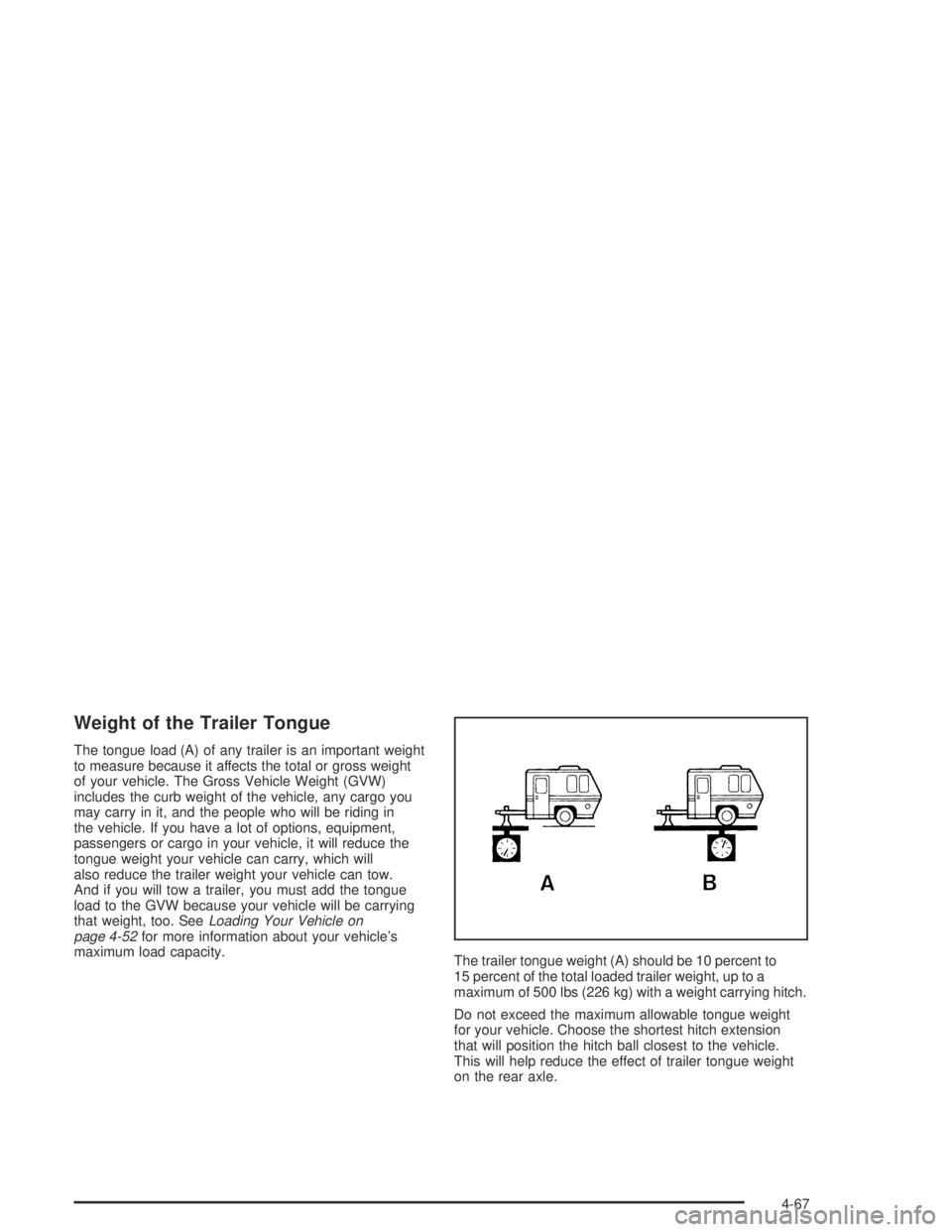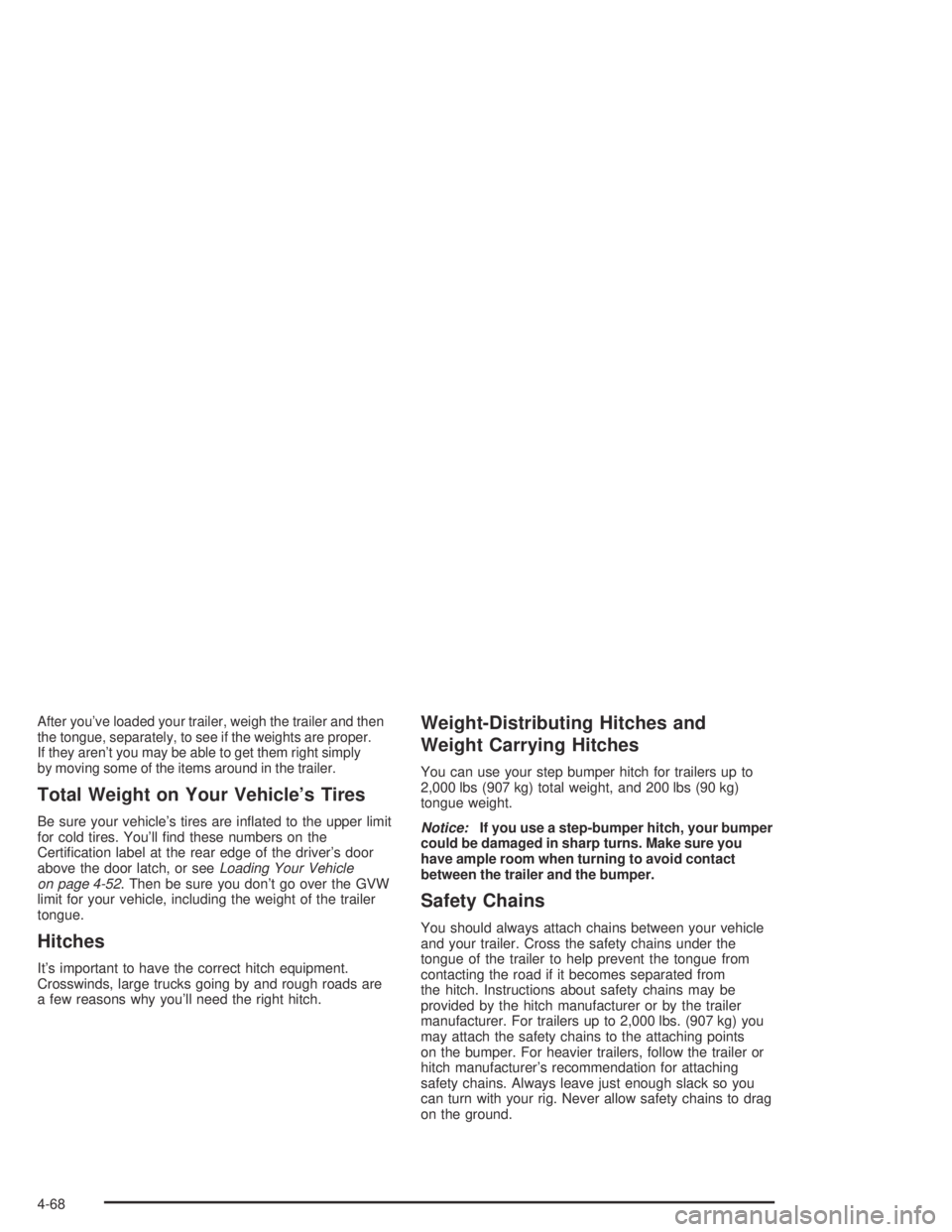Page 254 of 420
Vehicle* Axle Ratio Maximum Trailer Weight GCWR**
2WD Regular Cab
Automatic Transmission,
2.8 L Engine3.73 3,500 lbs. (1 587 kg) 7 000 lbs. (3 175 kg)
Automatic Transmission,
3.5 L Engine3.42 4,000 lbs. (1 814 kg) 8,500 lbs. (3 856 kg)
Automatic Transmission,
3.5 L Engine3.73 4,000 lbs. (1 814 kg) 8,500 lbs. (3 855 kg)
Manual Transmission,
2.8 L Engine3.42 2,000 lbs. (907 kg) 5,500 lbs. (2 495 kg)
Manual Transmission,
2.8 L Engine3.73 2,500 lbs. (1 133 kg) 6,000 lbs. (2 722 kg)
Manual Transmission,
3.5 L Engine3.42 3,500 lbs. (1 587 kg) 7,000 lbs. (3 175 kg)
Manual Transmission,
3.5 L Engine3.73 3,900 lbs. (1 769 kg) 7,500 lbs. (3 402 kg)
Vehicle* Axle Ratio Maximum Trailer Weight GCWR**
2WD Extended Cab
Automatic Transmission,
2.8 L Engine3.73 3,200 lbs. (1 451 kg) 7 000 lbs. (3 175 kg)
Automatic Transmission,
3.5 L Engine3.42 4,000 lbs. (1 814 kg) 8,500 lbs. (3 856 kg)
4-62
Page 255 of 420
Vehicle* Axle Ratio Maximum Trailer Weight GCWR**
Automatic Transmission,
3.5 L Engine3.73 4,000 lbs. (1 814 kg) 9,000 lbs. (4 082 kg)
Manual Transmission,
2.8 L Engine3.42 1,700 lbs. (771 kg) 5,500 lbs. (2 495 kg)
Manual Transmission,
2.8 L Engine3.73 2,200 lbs. (997 kg) 6,000 lbs. (2 722 kg)
Manual Transmission,
3.5 L Engine3.42 3,200 lbs. (1 451 kg) 7,000 lbs. (3 175 kg)
Manual Transmission,
3.5 L Engine3.73 3,600 lbs. (1 633 kg) 7,500 lbs. (3 402 kg)
Vehicle* Axle Ratio Maximum Trailer Weight GCWR**
2WD Crew Cab
®
Automatic Transmission,
2.8 L Engine3.73 3,100 lbs. (1 406 kg) 7,000 lbs. (3 175 kg)
Automatic Transmission,
3.5 L Engine3.42 4,000 lbs. (1 814 kg) 8,500 lbs. (3 856 kg)
Automatic Transmission,
3.5 L Engine3.73 4,000 lbs. (1 814 kg) 9,000 lbs. (4 082 kg)
Manual Transmission,
2.8 L Engine3.42 1,600 lbs. (725 kg) 5,500 lbs. (2 495 kg)
Manual Transmission,
2.8 L Engine3.73 2,100 lbs. (952 kg) 6,000 lbs. (2 722 kg)
4-63
Page 256 of 420
Vehicle* Axle Ratio Maximum Trailer Weight GCWR**
4WD Regular Cab
Automatic Transmission,
2.8 L Engine3.73 3,100 lbs. (1 406 kg) 7 000 lbs. (3 175 kg)
Automatic Transmission,
2.8 L Engine4.10 3,100 lbs. (1 406 kg) 7 000 lbs. (3 175 kg)
Automatic Transmission,
3.5 L Engine3.42 4,000 lbs. (1 814 kg) 8,500 lbs. (3 856 kg)
Automatic Transmission,
3.5 L Engine3.73 4,000 lbs. (1 814 kg) 9,000 lbs. (4 082 kg)
Automatic Transmission,
3.5 L Engine4.10 4,000 lbs. (1 814 kg) 9,000 lbs. (4 082 kg)
Manual Transmission,
2.8 L Engine3.73 2,100 lbs. (952 kg) 6,000 lbs. (2 722 kg)
Manual Transmission,
2.8 L Engine4.10 2,100 lbs. (952 kg) 6,000 lbs. (2 722 kg)
Manual Transmission,
3.5 L Engine3.42 3,100 lbs. (1 406 kg) 7,000 lbs. (3 175 kg)
Manual Transmission,
3.5 L Engine3.73 3,600 lbs. (1 632 kg) 7,500 lbs. (3 402 kg)
Manual Transmission,
3.5 L Engine4.10 3,500 lbs. (1 587 kg) 7,500 lbs. (3 402 kg)
4-64
Page 257 of 420
Vehicle* Axle Ratio Maximum Trailer Weight GCWR**
4WD Extended Cab
Automatic Transmission,
2.8 L Engine3.73 2,900 lbs. (1 315 kg) 7 000 lbs. (3 175 kg)
Automatic Transmission,
2.8 L Engine4.10 2,900 lbs. (1 315 kg) 7 000 lbs. (3 175 kg)
Automatic Transmission,
3.5 L Engine3.42 4,000 lbs. (1 814 kg) 8,500 lbs. (3 856 kg)
Automatic Transmission,
3.5 L Engine3.73 4,000 lbs. (1 814 kg) 9,000 lbs. (4 082 kg)
Automatic Transmission,
3.5 L Engine4.10 4,000 lbs. (1 814 kg) 9,000 lbs. (4 082 kg)
Manual Transmission,
2.8 L Engine4.10 1,900 lbs. (861 kg) 6,000 lbs. (2 722 kg)
Manual Transmission,
3.5 L Engine3.42 2,900 lbs. (1 315 kg) 7,000 lbs. (3 175 kg)
Manual Transmission,
3.5 L Engine3.73 3,400 lbs. (1 542 kg) 7,500 lbs. (3 402 kg)
Manual Transmission,
3.5 L Engine4.10 3,300 lbs. (1 496 kg) 7,500 lbs. (3 402 kg)
4-65
Page 258 of 420

Vehicle* Axle Ratio Maximum Trailer Weight GCWR**
4WD Crew Cab
®
Automatic Transmission,
2.8 L Engine3.73 2,800 lbs. (1 270 kg) 7 000 lbs. (3 175 kg)
Automatic Transmission,
2.8 L Engine4.10 2,800 lbs. (1 270 kg) 7 000 lbs. (3 175 kg)
Automatic Transmission,
3.5 L Engine3.42 4,000 lbs. (1 814 kg) 8,500 lbs. (3 856 kg)
Automatic Transmission,
3.5 L Engine3.73 4,000 lbs. (1 814 kg) 9,000 lbs. (4 082 kg)
Automatic Transmission,
3.5 L Engine4.10 4,000 lbs. (1 814 kg) 9,000 lbs. (4 082 kg)
Manual Transmission,
2.8 L Engine4.10 1,800 lbs. (816 kg) 6,000 lbs. (2 721 kg)
**The Gross Combination Weight Rating (GCWR) is the total allowable weight of the completely loaded vehicle and
trailer including any passengers, cargo, equipment and conversions. The GCWR for your vehicle should not be
exceeded.
You can ask your dealer for our trailering information or
advice, or you can write us at the address listed in
your Warranty and Owner Assistance Information
Booklet.In Canada, write to:
General Motors of Canada Limited
Customer Communication Centre, 163-005
1908 Colonel Sam Drive
Oshawa, Ontario L1H 8P7
4-66
Page 259 of 420

Weight of the Trailer Tongue
The tongue load (A) of any trailer is an important weight
to measure because it affects the total or gross weight
of your vehicle. The Gross Vehicle Weight (GVW)
includes the curb weight of the vehicle, any cargo you
may carry in it, and the people who will be riding in
the vehicle. If you have a lot of options, equipment,
passengers or cargo in your vehicle, it will reduce the
tongue weight your vehicle can carry, which will
also reduce the trailer weight your vehicle can tow.
And if you will tow a trailer, you must add the tongue
load to the GVW because your vehicle will be carrying
that weight, too. SeeLoading Your Vehicle on
page 4-52for more information about your vehicle’s
maximum load capacity.
The trailer tongue weight (A) should be 10 percent to
15 percent of the total loaded trailer weight, up to a
maximum of 500 lbs (226 kg) with a weight carrying hitch.
Do not exceed the maximum allowable tongue weight
for your vehicle. Choose the shortest hitch extension
that will position the hitch ball closest to the vehicle.
This will help reduce the effect of trailer tongue weight
on the rear axle.
4-67
Page 260 of 420

After you’ve loaded your trailer, weigh the trailer and then
the tongue, separately, to see if the weights are proper.
If they aren’t you may be able to get them right simply
by moving some of the items around in the trailer.
Total Weight on Your Vehicle’s Tires
Be sure your vehicle’s tires are in�ated to the upper limit
for cold tires. You’ll �nd these numbers on the
Certi�cation label at the rear edge of the driver’s door
above the door latch, or seeLoading Your Vehicle
on page 4-52. Then be sure you don’t go over the GVW
limit for your vehicle, including the weight of the trailer
tongue.
Hitches
It’s important to have the correct hitch equipment.
Crosswinds, large trucks going by and rough roads are
a few reasons why you’ll need the right hitch.
Weight-Distributing Hitches and
Weight Carrying Hitches
You can use your step bumper hitch for trailers up to
2,000 lbs (907 kg) total weight, and 200 lbs (90 kg)
tongue weight.
Notice:If you use a step-bumper hitch, your bumper
could be damaged in sharp turns. Make sure you
have ample room when turning to avoid contact
between the trailer and the bumper.
Safety Chains
You should always attach chains between your vehicle
and your trailer. Cross the safety chains under the
tongue of the trailer to help prevent the tongue from
contacting the road if it becomes separated from
the hitch. Instructions about safety chains may be
provided by the hitch manufacturer or by the trailer
manufacturer. For trailers up to 2,000 lbs. (907 kg) you
may attach the safety chains to the attaching points
on the bumper. For heavier trailers, follow the trailer or
hitch manufacturer’s recommendation for attaching
safety chains. Always leave just enough slack so you
can turn with your rig. Never allow safety chains to drag
on the ground.
4-68
Page 261 of 420

Trailer Brakes
If your trailer weighs more than 1,000 lbs. (450 kg)
loaded, then it needs its own brake – and they must be
adequate. Be sure to read and follow the instructions
for the trailer brakes so you’ll be able to install,
adjust and maintain them properly.
Your trailer’s brake system can tap into the vehicle’s
hydraulic brake system only if:
The trailer parts can withstand 3,000 psi
(20 650 kPa) of pressure.
The trailer’s brake system will use less than
0.02 cubic inch (0.3 cc) of �uid from your vehicle’s
master cylinder. Otherwise, both braking systems
won’t work well. You could even lose your brakes.
If everything checks out this far, then make the brake
�uid tap at the port on the master cylinder that
sends �uid to the rear brakes. But don’t use copper
tubing for this. If you do, it will bend and �nally break off.
Use steel brake tubing.
Driving with a Trailer
Towing a trailer requires a certain amount of experience.
Before setting out for the open road, you’ll want to get
to know your rig. Acquaint yourself with the feel of
handling and braking with the added weight of the trailer.
And always keep in mind that the vehicle you are
driving is now a good deal longer and not nearly as
responsive as your vehicle is by itself.
Before you start, check all trailer hitch parts and
attachments, safety chains, electrical connector, lamps,
tires and mirror adjustment. If the trailer has electric
brakes, start your vehicle and trailer moving and then
apply the trailer brake controller by hand to be sure
the brakes are working. This lets you check your
electrical connection at the same time.
During your trip, check occasionally to be sure that the
load is secure, and that the lamps and any trailer
brakes are still working.
4-69